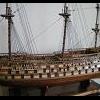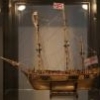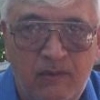-
Posts
3,084 -
Joined
-
Last visited
Reputation Activity
-
 Jaager got a reaction from BLACK VIKING in Deck Planking Pattern for Spanish 1690's Warship
Jaager got a reaction from BLACK VIKING in Deck Planking Pattern for Spanish 1690's Warship
Deck plank for USN between 1815-1860 is 40' Pine. By the 1690's ship building
was probably well on its way into bureaucracy - Spain included. Unlike the 1500's
when it was more father to son - we keep the rules secret - sort of thing.
I would use 40 as the max - use 30" as average - and use 3 plank shift - not as busy looking
and "more professional" in strength potential - full size.
You might consider an e-mail about this to Thomas J. Oertling at Texas A&M -
he wrote a chapter in The Philosophy of Shipbuilding on 15-16 C. Iberian wrecks.
The Nautical Archaeology folks may have data.
-
 Jaager got a reaction from Sgt Mike in Strips from a Band Saw
Jaager got a reaction from Sgt Mike in Strips from a Band Saw
Are you resawing from a plank or cutting planking, deck beams, etc from a thin sheet so that one dimension
is already at the desired thickness?
If you are resawing, a Wood Slicer blade is about as thin as it gets and the set is slight so
not as many passes thru a thickness sander. I recently got a catalog with Infinity rip blades
that look identical to Wood Slicer - no better on price though.
On rip cuts thru thick stock more teeth is the opposite of what is needed.
Resawing using a table saw - is brute force, even a 12 inch saw may not be able to go 4" deep
in one go, really wants to kick back the stock, and is waiting for your fingers.
Resawing on a band saw is an art. A UTube video link here had one tip that seems key - the traditional advice
for blade tracking is wrong. The way to limit blade wandering is to track the blade so that the actual teeth
are at the crown of the top wheel. and are directly supported.
For working stock from a thin sheet, the kerf on a 10-12 " table saw will cost you much material.
A Byrnes 4" table saw a more efficient tool - there are blades with zero set so stock produced has a ready to
use cut surface. Even with this, the TPI on a blade needs to match the thickness of the stock.
With too fine a blade, the gullets fill too early and no longer can cut - just generate heat.
My band saw is an old 3 wheel with a 3/4 HP motor, If I had a wayback machine, it would be a 14 inch two wheel
2 HP motor. I did not think to wire my garage for 220 V some that limits motor size.
-
 Jaager got a reaction from davyboy in Wood filler
Jaager got a reaction from davyboy in Wood filler
Rather than use filler, why not scab it?
Get a flat at the spot and PVA glue a piece of hardwood to it and shape that.
-
 Jaager got a reaction from michael101 in Wood filler
Jaager got a reaction from michael101 in Wood filler
Rather than use filler, why not scab it?
Get a flat at the spot and PVA glue a piece of hardwood to it and shape that.
-
 Jaager got a reaction from mtaylor in Oscillating Spindle Sander to get one or not.
Jaager got a reaction from mtaylor in Oscillating Spindle Sander to get one or not.
I think this sort of tool is the most efficient for shaping frames.
A tilting table is not helpful for sanding frames. The bevel is in constant change in angle.
I have to do it in the air. A tilting table is a source for mis-adjustment. The table is OK for
support for extreme outer shape and inside most mould line.
The main use that I can see for the tilting table would be for cutting a bevel on a waterway.
There are ways to do that.
I wish to use stock sheet sandpaper instead of the pre-formed tubes - cost and to deal with
my aversion to being beholden to a single source for disposable media.
The spindle ossilating motion is not one I wish to use.
I made my own, using a 1/3 HP reversible motor. The CW-CCW rotation option is helpful in sanding
the top of frames. The open ends respond better to pull than push. The sleeveless drums I use all mount
on the bare 1/2" motor shaft and I can mount cutting burrs and rotary shapers.
They are of some help, but 60 -80 grit sandpaper does bulk removal at least as well.
A drill press - the motor is in the way. If it could be rotated 180 degrees - it could do -
if you can get 1700 RPM out of it.
-
 Jaager got a reaction from Canute in Oscillating Spindle Sander to get one or not.
Jaager got a reaction from Canute in Oscillating Spindle Sander to get one or not.
I think this sort of tool is the most efficient for shaping frames.
A tilting table is not helpful for sanding frames. The bevel is in constant change in angle.
I have to do it in the air. A tilting table is a source for mis-adjustment. The table is OK for
support for extreme outer shape and inside most mould line.
The main use that I can see for the tilting table would be for cutting a bevel on a waterway.
There are ways to do that.
I wish to use stock sheet sandpaper instead of the pre-formed tubes - cost and to deal with
my aversion to being beholden to a single source for disposable media.
The spindle ossilating motion is not one I wish to use.
I made my own, using a 1/3 HP reversible motor. The CW-CCW rotation option is helpful in sanding
the top of frames. The open ends respond better to pull than push. The sleeveless drums I use all mount
on the bare 1/2" motor shaft and I can mount cutting burrs and rotary shapers.
They are of some help, but 60 -80 grit sandpaper does bulk removal at least as well.
A drill press - the motor is in the way. If it could be rotated 180 degrees - it could do -
if you can get 1700 RPM out of it.
-
 Jaager got a reaction from WackoWolf in Wood filler
Jaager got a reaction from WackoWolf in Wood filler
Rather than use filler, why not scab it?
Get a flat at the spot and PVA glue a piece of hardwood to it and shape that.
-
 Jaager got a reaction from Canute in Wood filler
Jaager got a reaction from Canute in Wood filler
Rather than use filler, why not scab it?
Get a flat at the spot and PVA glue a piece of hardwood to it and shape that.
-
 Jaager got a reaction from mtaylor in Framing Math
Jaager got a reaction from mtaylor in Framing Math
Some tips for the drawing program:
Save often.
Name every layer.
Use the Group layers function where possible.
Lock layers that are important -- distraction from which layer you are on is the rule rather than the exception.
Work on duplicates of important layers. If the changes make the original redundant, then you can then delete it.
If the programmers at Corel are the same for PSP as Painter -- if you get into a lot of backing and filling when scaling or rotating a layer - and then you try to delete or Cut something - the program will crash. You will wish you had saved.
If the file is too large - and it is tempting to have one large file - Painter at least - gets squirrely - it inserts green blocks onto many if not most layers - the whole file gets useless.
Break it up into smaller files. One or four Sections per file may keep the size in a practical range.
Your color selector window is likely the ring with a triangle in the middle. The are three slides below that that are Red 0-255 Green 0-255 Blue 0-255
I cycle my color for each frame shape R -G - B - just slide all the way to 255 - saves having to choose a color the thousands possible. I start with the dead flat as red and
green next forward and green next aft. When you come to sanding the bevel, you know that red is the mid facing with R-G, green mid facing with G-B, and blue mid facing
with B-R. That way you do not have the floor timber on the wrong side of the bevel and have to remake the frame.
-
 Jaager got a reaction from mtaylor in Framing Math
Jaager got a reaction from mtaylor in Framing Math
Reviewing the 6 articles, you seem to have stepped into a controversy.
1- the Underhill plans are 1/5" : 1' or 1:60 -- his stern has a good chance of being incorrect.
NRJ vol. 35 page 28+ 1990 by Marquardt is available here for download = $ 2.50
I would use the Marquardt plans - but buying 2nd copy is not reasonable - what is available is $160 - $260 each.
There is a break at the seam so it should scan OK.
-
 Jaager got a reaction from mtaylor in Framing Math
Jaager got a reaction from mtaylor in Framing Math
VWM,
That PSP X9 deal sounds good. and that is the program. Another free option is GIMP - it may be too much in complexity for what is needed.
I have not needed to use PaintShop Pro, but I have been aware of it since its JASCA days - pre Corel. You only need basic functions - but
the program has to be able to handle large files. A program that I liked - but Corel bought and shelved was Picture Publisher - it needed to be
coded for new Intel chips to run and it wasn't.
When you scan, the profile and WL plans can be done in segments round each station line. The whole as a unit is too large and cumbersome to
be directly useful anyway. The keel is all that you need it for as a whole.
A background grid - centerline - baseline - waterlines - buttock lnes - and diagonals if used makes location easy.
The profile station strip can be duplicated and moved to each grid point so that when you plot the curve, no points need to be placed first.
If the pre- and post- station curves are also in the background, you can easily see anything going wrong.
As I said, the line segment drawing tool will get you a fair enough curve. A curve drawing tool would be cumbersome and introduce artifacts by making
its equation based curve instead of what you want. I do not see much of a facetted line effect in my product - and even if I wanted that, my drum sander
would not let be get it anyway.
I have found 4 references to Endeavour in MS thru '95 and 2 in NRJ in '76 and '90. The last is by Marquardt. I will see if any are of help re: the plans problem.
-
 Jaager got a reaction from mtaylor in Strips from a Band Saw
Jaager got a reaction from mtaylor in Strips from a Band Saw
Are you resawing from a plank or cutting planking, deck beams, etc from a thin sheet so that one dimension
is already at the desired thickness?
If you are resawing, a Wood Slicer blade is about as thin as it gets and the set is slight so
not as many passes thru a thickness sander. I recently got a catalog with Infinity rip blades
that look identical to Wood Slicer - no better on price though.
On rip cuts thru thick stock more teeth is the opposite of what is needed.
Resawing using a table saw - is brute force, even a 12 inch saw may not be able to go 4" deep
in one go, really wants to kick back the stock, and is waiting for your fingers.
Resawing on a band saw is an art. A UTube video link here had one tip that seems key - the traditional advice
for blade tracking is wrong. The way to limit blade wandering is to track the blade so that the actual teeth
are at the crown of the top wheel. and are directly supported.
For working stock from a thin sheet, the kerf on a 10-12 " table saw will cost you much material.
A Byrnes 4" table saw a more efficient tool - there are blades with zero set so stock produced has a ready to
use cut surface. Even with this, the TPI on a blade needs to match the thickness of the stock.
With too fine a blade, the gullets fill too early and no longer can cut - just generate heat.
My band saw is an old 3 wheel with a 3/4 HP motor, If I had a wayback machine, it would be a 14 inch two wheel
2 HP motor. I did not think to wire my garage for 220 V some that limits motor size.
-
 Jaager got a reaction from RichardG in Framing Math
Jaager got a reaction from RichardG in Framing Math
Some tips for the drawing program:
Save often.
Name every layer.
Use the Group layers function where possible.
Lock layers that are important -- distraction from which layer you are on is the rule rather than the exception.
Work on duplicates of important layers. If the changes make the original redundant, then you can then delete it.
If the programmers at Corel are the same for PSP as Painter -- if you get into a lot of backing and filling when scaling or rotating a layer - and then you try to delete or Cut something - the program will crash. You will wish you had saved.
If the file is too large - and it is tempting to have one large file - Painter at least - gets squirrely - it inserts green blocks onto many if not most layers - the whole file gets useless.
Break it up into smaller files. One or four Sections per file may keep the size in a practical range.
Your color selector window is likely the ring with a triangle in the middle. The are three slides below that that are Red 0-255 Green 0-255 Blue 0-255
I cycle my color for each frame shape R -G - B - just slide all the way to 255 - saves having to choose a color the thousands possible. I start with the dead flat as red and
green next forward and green next aft. When you come to sanding the bevel, you know that red is the mid facing with R-G, green mid facing with G-B, and blue mid facing
with B-R. That way you do not have the floor timber on the wrong side of the bevel and have to remake the frame.
-
 Jaager got a reaction from WackoWolf in Strips from a Band Saw
Jaager got a reaction from WackoWolf in Strips from a Band Saw
Are you resawing from a plank or cutting planking, deck beams, etc from a thin sheet so that one dimension
is already at the desired thickness?
If you are resawing, a Wood Slicer blade is about as thin as it gets and the set is slight so
not as many passes thru a thickness sander. I recently got a catalog with Infinity rip blades
that look identical to Wood Slicer - no better on price though.
On rip cuts thru thick stock more teeth is the opposite of what is needed.
Resawing using a table saw - is brute force, even a 12 inch saw may not be able to go 4" deep
in one go, really wants to kick back the stock, and is waiting for your fingers.
Resawing on a band saw is an art. A UTube video link here had one tip that seems key - the traditional advice
for blade tracking is wrong. The way to limit blade wandering is to track the blade so that the actual teeth
are at the crown of the top wheel. and are directly supported.
For working stock from a thin sheet, the kerf on a 10-12 " table saw will cost you much material.
A Byrnes 4" table saw a more efficient tool - there are blades with zero set so stock produced has a ready to
use cut surface. Even with this, the TPI on a blade needs to match the thickness of the stock.
With too fine a blade, the gullets fill too early and no longer can cut - just generate heat.
My band saw is an old 3 wheel with a 3/4 HP motor, If I had a wayback machine, it would be a 14 inch two wheel
2 HP motor. I did not think to wire my garage for 220 V some that limits motor size.
-
 Jaager got a reaction from Heronguy in Strips from a Band Saw
Jaager got a reaction from Heronguy in Strips from a Band Saw
Are you resawing from a plank or cutting planking, deck beams, etc from a thin sheet so that one dimension
is already at the desired thickness?
If you are resawing, a Wood Slicer blade is about as thin as it gets and the set is slight so
not as many passes thru a thickness sander. I recently got a catalog with Infinity rip blades
that look identical to Wood Slicer - no better on price though.
On rip cuts thru thick stock more teeth is the opposite of what is needed.
Resawing using a table saw - is brute force, even a 12 inch saw may not be able to go 4" deep
in one go, really wants to kick back the stock, and is waiting for your fingers.
Resawing on a band saw is an art. A UTube video link here had one tip that seems key - the traditional advice
for blade tracking is wrong. The way to limit blade wandering is to track the blade so that the actual teeth
are at the crown of the top wheel. and are directly supported.
For working stock from a thin sheet, the kerf on a 10-12 " table saw will cost you much material.
A Byrnes 4" table saw a more efficient tool - there are blades with zero set so stock produced has a ready to
use cut surface. Even with this, the TPI on a blade needs to match the thickness of the stock.
With too fine a blade, the gullets fill too early and no longer can cut - just generate heat.
My band saw is an old 3 wheel with a 3/4 HP motor, If I had a wayback machine, it would be a 14 inch two wheel
2 HP motor. I did not think to wire my garage for 220 V some that limits motor size.
-
 Jaager got a reaction from Canute in Strips from a Band Saw
Jaager got a reaction from Canute in Strips from a Band Saw
Are you resawing from a plank or cutting planking, deck beams, etc from a thin sheet so that one dimension
is already at the desired thickness?
If you are resawing, a Wood Slicer blade is about as thin as it gets and the set is slight so
not as many passes thru a thickness sander. I recently got a catalog with Infinity rip blades
that look identical to Wood Slicer - no better on price though.
On rip cuts thru thick stock more teeth is the opposite of what is needed.
Resawing using a table saw - is brute force, even a 12 inch saw may not be able to go 4" deep
in one go, really wants to kick back the stock, and is waiting for your fingers.
Resawing on a band saw is an art. A UTube video link here had one tip that seems key - the traditional advice
for blade tracking is wrong. The way to limit blade wandering is to track the blade so that the actual teeth
are at the crown of the top wheel. and are directly supported.
For working stock from a thin sheet, the kerf on a 10-12 " table saw will cost you much material.
A Byrnes 4" table saw a more efficient tool - there are blades with zero set so stock produced has a ready to
use cut surface. Even with this, the TPI on a blade needs to match the thickness of the stock.
With too fine a blade, the gullets fill too early and no longer can cut - just generate heat.
My band saw is an old 3 wheel with a 3/4 HP motor, If I had a wayback machine, it would be a 14 inch two wheel
2 HP motor. I did not think to wire my garage for 220 V some that limits motor size.
-
 Jaager got a reaction from mtaylor in Framing Math
Jaager got a reaction from mtaylor in Framing Math
Thru the 17 C. the shape of the key frame stations was defined using a formula based on the arc. For small craft at least - this became a process
= whole moulding. I am not sure how far into the 18 C this continued for ships. The shape produced is distinctive and to my eye, Endeavor does
not show those characteristics - so even if an equation for the arc system could be found, it is unlikely to apply to Endeavor. Her shape at mid ship
fairly close to being a rectangle - with rounded lower corners. It is probably efficient for maximizing cargo capacity - when speed is not at a premium.
Since the shape is already defined - ( not doing a new design ) - the points of the curve are predetermined - Even if the key Station curves are defined by
some formula, the intermediate bends that transition between them do not. I had guessed for a long time that a spline would connect the
points with the least introduction of artifact. The curves were probably originally drawn at the Stations using actual wooden splines. The traditional
method for lofting a POF model involves two or three curves for each paired frame (bend). There are as you say about 50 bends in the average ship -
or about 150 complex curves with essentially no two being identical. If you do the final shaping on a glued up pair then you are down to 100 curves.
This makes the published Station curves as being of no help for bend shaping. By using a program with layers the bends can be stacked and outlaying
points be seen and corrected. With the station lines are part of the data, they can be used as a guide to see where errors are being introduced.
( The Stations are generally every other bend in a small ship but are often every third or fourth in the middle of a larger ships and I have seen as many as eight .)
With enough points you can get by using a straight line connect the points tool. Any slight faceted effect on the frame pattern will not survive the sanding anyway.
Use a drawing program with the ability to handle a lot of layers and large files... Scan in the Body plan, Profile, Waterlines, and Buttock lines. Use them as a
background layer to define the points. This removes a source of error when the points are measured and transferred.
-
 Jaager got a reaction from Eddie in Endeavour 1934 by Julie Mo - Amati - Scale 1:35 - America's Cup UK J-Class Challenger
Jaager got a reaction from Eddie in Endeavour 1934 by Julie Mo - Amati - Scale 1:35 - America's Cup UK J-Class Challenger
You could make up the keel off the boat. Using a jig - plywood or glued up scrap cut and sanded to match the inside of the keel.
- a second piece that is the shape of the outside of the keel. The wet layers of the keel sandwiched and clamped between the inside and outside jigs
until dry, The keel should then lay naturally on the hull.
When the keel is dry from the wet clamping - you could fit the bottom two layers on the hull and drill holes for pins or bamboo dowels
thru the keel layers into the hull spine.then glued up and clamp the layers to set. After the glue up - the pins fit into the holes and used to site the keel. The outside lamina would hide the pins and keel would be more secure than if using glue alone.
-
 Jaager got a reaction from mtaylor in Deck capstan and gun ports
Jaager got a reaction from mtaylor in Deck capstan and gun ports
Charles G. Davis - The Built-Up Ship Model
Provides a rule - but as usual he did not footnote it, so exactly when it applied = ?
" gun ports are spaced apart, center to center, 25 times the diameter of the shot.
The gun port's length, fore and aft, should be 6.5 diameters; the height, 6 diameters;
and the sill or lower edge of the port should be 3.5 diameters above the deck
Davis points out that the location of the backstays should be considered.
I think it was Deane ( not gonna look it up ) who essentially suggested that it
is unwise to locate ports even with the masts. This was a time when all guns were on
rolling trucks. Perhaps carronades were less of a problem.
A windlass would favor a smaller crew. A lighter weight anchor would less force to
recover it.
-
 Jaager got a reaction from WaltB in Can you water bend glued wood?
Jaager got a reaction from WaltB in Can you water bend glued wood?
If you were to fabricate the multi layer bulwark complex and then bend it:
If the glue joints survived the stress - which is not likely.
If the interior components did not break due the the compression force - depending on the species of wood, also unlikely
The interior components would be applying force to reverse the bend.
If you pre bend each layer and then assemble it, the interior components will help hold the bent shape.
-
 Jaager got a reaction from achuck49 in How to chisel a solid hull boat
Jaager got a reaction from achuck49 in How to chisel a solid hull boat
Get a closet hanger dowel from a local hardware store.
The smaller dowels are often too dogleggy - or get that way -
to use as spars.
-
 Jaager got a reaction from vossiewulf in Deck capstan and gun ports
Jaager got a reaction from vossiewulf in Deck capstan and gun ports
Charles G. Davis - The Built-Up Ship Model
Provides a rule - but as usual he did not footnote it, so exactly when it applied = ?
" gun ports are spaced apart, center to center, 25 times the diameter of the shot.
The gun port's length, fore and aft, should be 6.5 diameters; the height, 6 diameters;
and the sill or lower edge of the port should be 3.5 diameters above the deck
Davis points out that the location of the backstays should be considered.
I think it was Deane ( not gonna look it up ) who essentially suggested that it
is unwise to locate ports even with the masts. This was a time when all guns were on
rolling trucks. Perhaps carronades were less of a problem.
A windlass would favor a smaller crew. A lighter weight anchor would less force to
recover it.
-
 Jaager got a reaction from mtaylor in Can you water bend glued wood?
Jaager got a reaction from mtaylor in Can you water bend glued wood?
If you were to fabricate the multi layer bulwark complex and then bend it:
If the glue joints survived the stress - which is not likely.
If the interior components did not break due the the compression force - depending on the species of wood, also unlikely
The interior components would be applying force to reverse the bend.
If you pre bend each layer and then assemble it, the interior components will help hold the bent shape.
-
 Jaager got a reaction from mtaylor in San Francisco II Discontinued
Jaager got a reaction from mtaylor in San Francisco II Discontinued
It is the nature of most wooden ship model kits that inferior stock lumber can be
easily replaced with better species of wood provided by vendors whose links are here.
The additional expense is not consequential when measured against the joy of working
with quality materials. The fittings can be similarly replaced - or self fabricated.
The skills and practice involved can become a major step in not needed to depend on
kits as a vessel choice.
-
 Jaager got a reaction from Canute in San Francisco II Discontinued
Jaager got a reaction from Canute in San Francisco II Discontinued
It is the nature of most wooden ship model kits that inferior stock lumber can be
easily replaced with better species of wood provided by vendors whose links are here.
The additional expense is not consequential when measured against the joy of working
with quality materials. The fittings can be similarly replaced - or self fabricated.
The skills and practice involved can become a major step in not needed to depend on
kits as a vessel choice.














